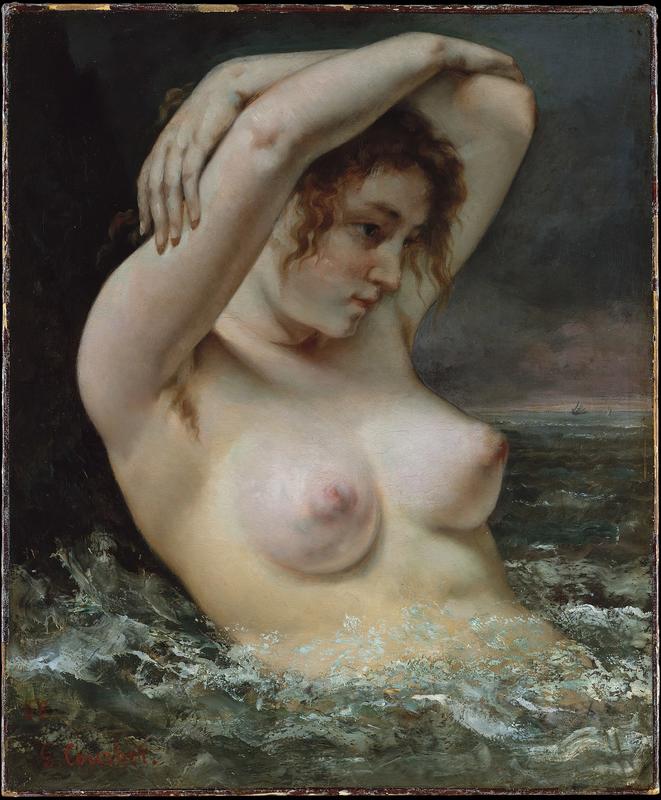More about The Woman in the Waves
- All
- Info
- Shop

Sr. Contributor
Courbet wasn’t afraid to show his models in all their nude, hairy glory.
Origin of the World is a prime example of Courbet’s penchant for the natural, female body, but if you’re not ready for some full-on bush, this mild underarm hair should do just fine. After all, not everyone is into this type of body acceptance, especially those who were around to see this painting when it debuted in the nineteenth century.
Before Courbet debuted his risque pictures, Romanticism ruled the contemporary art scene in France. As a burgeoning artist, Courbet admired the Romantics, especially Delacroix, although he was never really into his predecessor’s made-up scenes. Ever the rebel, Courbet did everything he could to subvert outmoded, academic traditions. His socialist side made him declare that contemporary life – in all its dirty, ugly, and hairy truth – was the best and most valid subject for modern painting.
This painting harks back to the myth of Venus but rejects all traditional ways of representing the goddess of love. It is the total antithesis of what academicians like Bouguereau were all about. His Birth of Venus has no trace of armpit hair and definitely no pubic hair. She is a pristine and pure woman – not some hairy tramp! Courbet’s new take on this notorious scene threw hundreds of years of art history, dating back to Botticelli’s Birth of Venus, right in the trash.
This connection to Botticelli’s traditional take on the myth, an absolute treasure of Italian Renaissance art, actually illuminates some hilarious background on the Courbet painting. Before becoming part of the Met’s collection, this Courbet belonged to Henry Osborne Havemeyer, an aggressive and ruthless business man who ran an American sugar empire out of Brooklyn. Havemeyer and his wife Louisine loved to collect art and amassed an impressive collection. The Havemeyers must have been a little out of their minds because they actually attempted to buy Botticelli’s masterpiece. Italian authorities reacted exactly as you might expect – by saying no freakin’ way.
The Havemeyers did succeed, however, in assembling the largest collection of Courbet nudes in the world. I guess they decided that if they couldn’t have the Botticelli, they could get the guy who dismantled the Renaissance genius’s entire tradition. Bold move, Havemeyers. Thanks to a lucrative sugar business and a lust for art, this and thousands of other works now belong to the Met. The bequest in 1929 finally made the Met a key player among national museums in the realm of European paintings. In nineteenth-century French painting, the Met is now ranked second only to the Orsay Museum in Paris. If you ask me, it’s a pretty big accomplishment to rate so closely to the place where this art actually came from.
Sources
- Davies, Penelope J.E., Frima Fox Hofrichter, Joseph Jacobs, Ann M. Roberts, and David L. Simon. Janson’s Basic History of Western Art. 8th edition. Upper Saddle River, NJ: Pearson Education, Inc., 2009.
- Gompertz, Will. What Are You Looking At? New York: Plume, 2012.
- Kimmelman, Michael. “Review/Art; Havemeyer Collection: Magic at the Met Museum.” New York Times. March 26, 1993. http://www.nytimes.com/1993/03/26/arts/review-art-havemeyer-collection-…. Accessed December 11, 2017
- The Metropolitan Museum of Art. “The Woman in the Waves.” Collection. https://www.metmuseum.org/art/collection/search/436004. Accessed December 11, 2017.
- Tinterow, Gary. “The Havemeyer Pictures.” In Splendid Legacy: The Havemeyer Collection. New York: The Metropolitan Museum of Art, 1993.
Featured Content
Here is what Wikipedia says about The Woman in the Waves
The Woman in the Waves (French - La Femme à la vague) is an 1868 painting by the French Realist painter Gustave Courbet, now in the Metropolitan Museum of Art in New York.
The picture is notable for its realistic flesh tones and trace of underarm hair.
The work is on view in the Metropolitan Museum's Gallery 811.
Check out the full Wikipedia article about The Woman in the Waves














